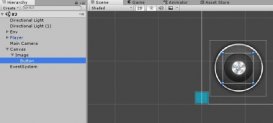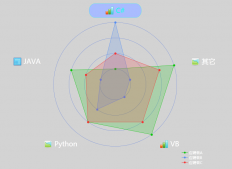本文实例为大家分享了unityshader实现运动模糊的具体代码,供大家参考,具体内容如下
原理:
像素的当前帧的ndc坐标(x,y值由uv映射而来,z值由深度值映射而来)——(使用_currentviewprojectioninversemartix变换,并除以w分量)—— 像素的世界坐标 ——(使用_previousviewprojectionmatrix变换,并除以w分量)—— 像素的前一帧的ndc坐标 —— (当前帧ndc-前一帧ndc)—— 速度
1.此代码挂在摄像机上,使摄像机运动起来
|
1
2
3
4
5
6
7
8
9
10
11
12
13
14
15
16
17
18
19
20
21
22
23
24
25
26
27
28
29
30
|
using unityengine; using system.collections; public class translating : monobehaviour { public float speed = 10.0f; public vector3 startpoint = vector3.zero; public vector3 endpoint = vector3.zero; public vector3 lookat = vector3.zero; public bool pingpong = true; private vector3 curendpoint = vector3.zero; // use this for initialization void start () { transform.position = startpoint; curendpoint = endpoint; } // update is called once per frame void update () { transform.position = vector3.slerp(transform.position, curendpoint, time.deltatime * speed); transform.lookat(lookat); if (pingpong) { if (vector3.distance(transform.position, curendpoint) < 0.001f) { curendpoint = vector3.distance(curendpoint, endpoint) < vector3.distance(curendpoint, startpoint) ? startpoint : endpoint; } } } } |
2.此代码挂在摄像机上
|
1
2
3
4
5
6
7
8
9
10
11
12
13
14
15
16
17
18
19
20
21
22
23
24
25
26
27
28
29
30
31
32
33
34
35
36
37
38
39
40
41
42
43
44
45
46
47
48
49
50
51
52
53
54
55
56
57
58
59
60
61
62
63
64
65
66
67
68
69
70
71
72
73
74
75
|
using system.collections;using system.collections.generic;using unityengine; public class motionblurwithdepthtexture : posteffectsbase{ public shader motionblurshader; private material _motionblurmaterial = null; public material material { get { _motionblurmaterial = checkshaderandcreatematerial(motionblurshader, _motionblurmaterial); return _motionblurmaterial; } } //定义运动模糊时模糊图像使用的大小 [range(0.0f, 1.0f)] public float blursize = 0.5f; //定义一个camera变量,获取该脚本所在的摄像机组建,得到摄像机的视角和投影矩阵 private camera _mycamera; public camera camera { get { if (_mycamera == null) { _mycamera = getcomponent<camera>(); } return _mycamera; } } //定义一个变量保存 上一帧摄像机的视角 * 投影矩阵 private matrix4x4 _previousviewprojectionmatrix; //在onenable中设置摄像机的状态,以获得深度纹理 void onenable() { camera.depthtexturemode = depthtexturemode.depth; } void onrenderimage(rendertexture src, rendertexture dest) { if (material != null) { //将模糊大小传给shader material.setfloat("_blursize", blursize); //使用 视角 * 投影矩阵 对ndc(归一化的设备坐标)下的顶点坐标进行变换,得到该像素在世界空间下的位置 //计算前一帧与当前帧的位置差,生成该像素的速度 //将 前一帧视角 * 投影矩阵 传给shader material.setmatrix("_previousviewprojectionmatrix", _previousviewprojectionmatrix); //计算 当前帧视角 * 投影矩阵 //camera.projectionmatrix获得当前摄像机投影矩阵 //camera.worldtocameramatrix获得当前摄像机视角矩阵 matrix4x4 currentviewprojectionmartix = camera.projectionmatrix * camera.worldtocameramatrix; //计算 当前帧视角 * 投影矩阵 的逆矩阵 matrix4x4 currentviewprojectioninversemartix = currentviewprojectionmartix.inverse; //将当前帧视角 * 投影矩阵 的逆矩阵 传递给shader material.setmatrix("_currentviewprojectioninversemartix", currentviewprojectioninversemartix); //将 当前帧视角 * 投影矩阵 保存为 前一帧视角 * 投影矩阵 _previousviewprojectionmatrix = currentviewprojectionmartix; graphics.blit(src, dest, material); } else { graphics.blit(src, dest); } }} |
3.此shader赋值给代码2
|
1
2
3
4
5
6
7
8
9
10
11
12
13
14
15
16
17
18
19
20
21
22
23
24
25
26
27
28
29
30
31
32
33
34
35
36
37
38
39
40
41
42
43
44
45
46
47
48
49
50
51
52
53
54
55
56
57
58
59
60
61
62
63
64
65
66
67
68
69
70
71
72
73
74
75
76
77
78
79
80
81
82
83
84
85
86
87
88
89
90
91
92
93
94
95
96
97
|
shader "unity shaders book/chapter 13/motionblurwithdepthtexture"{ properties { _maintex ("base (rgb)", 2d) = "white" {} //模糊图像时使用的参数 _blursize ("blur size", float) = 1.0 //这里并没有声明_previousviewprojectionmatrix和_currentviewprojectioninversemartix //是因为unity并没有提供矩阵类型的属性,但仍然可以在cg代码块中定义这些矩阵,并从脚本中设置它们 } subshader { cginclude #include "unitycg.cginc" sampler2d _maintex; //使用_maintex_texelsize变量来对深度纹理的采样坐标进行平台化差异处理 half4 _maintex_texelsize; //unity传递来的深度纹理 sampler2d _cameradepthtexture; //声明_previousviewprojectionmatrix和_currentviewprojectioninversemartix float4x4 _previousviewprojectionmatrix; float4x4 _currentviewprojectioninversemartix; half _blursize; //定义顶点着色器 struct v2f { float4 pos : sv_position; half2 uv : texcoord0; //添加了用于深度纹理采样的纹理坐标变量 half2 uv_depth : texcoord1; }; v2f vert(appdata_img v) { v2f o; o.pos = unityobjecttoclippos(v.vertex); o.uv = v.texcoord; o.uv_depth = v.texcoord; //平台差异化处理 #if unity_uv_starts_at_top if (_maintex_texelsize.y < 0) { o.uv_depth.y = 1 - o.uv_depth.y; } #endif return o; } //定义片元着色器 fixed4 frag(v2f i) : sv_target{ //使用宏和纹理坐标对深度纹理进行采样,得到深度值 float d = sample_depth_texture(_cameradepthtexture, i.uv_depth); //构建当前像素的ndc坐标,xy坐标由像素的纹理坐标映射而来,z坐标由深度值d映射而来 float4 h = float4(i.uv.x * 2 - 1, i.uv.y * 2 - 1, d * 2 - 1, 1); //使用 当前帧的视角 * 投影矩阵 的逆矩阵 对h进行变换 float4 d = mul(_currentviewprojectioninversemartix, h); //把结果除以它的w分量,得到该像素世界空间下的坐标 float4 worldpos = d / d.w; //像素当前帧ndc坐标 float4 currentpos = h; //使用 前一帧视角 * 投影矩阵 变换世界空间的的坐标worldpos,并除以它的w分量,得到前一帧的ndc坐标 float4 previouspos = mul(_previousviewprojectionmatrix, worldpos); previouspos /= previouspos.w; //计算当前帧与前一帧在屏幕空间下的位置差,得到该像素的速度 float2 velocity = (currentpos.xy - previouspos.xy) / 2.0f; //使用速度值对邻域像素进行采样,相加后取平均值得到一个模糊效果,使用_blursize控制采样距离 float2 uv = i.uv; float4 c = tex2d(_maintex, uv); uv += velocity * _blursize; for (int it = 1; it < 3; it++, uv += velocity * _blursize) { float4 currentcolor = tex2d(_maintex, uv); c += currentcolor; } c /= 3; return fixed4(c.rgb, 1.0); } endcg pass { ztest always cull off zwrite off cgprogram #pragma vertex vert #pragma fragment frag endcg } } fallback off} |

以上就是本文的全部内容,希望对大家的学习有所帮助,也希望大家多多支持服务器之家。
原文链接:https://blog.csdn.net/weixin_37994402/article/details/79578751


















